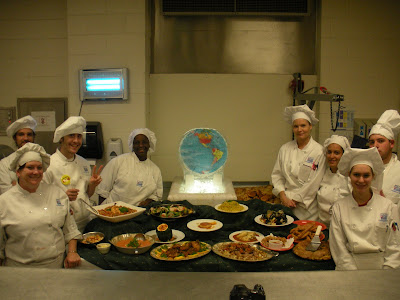I thought it would be fun to talk about a class I teach at the college. It's called "International Cuisine" and it is one of my most exciting classes.
Featured countries usually include Spain, France, Italy, Japan, Mexico, Thailand, Viet Nam, Turkey, Greece, Brazil, Argentina, Chile, The Caribbean, Peru, India, Morocco, Nigeria or Germany. I feel that the above countries offer interesting culinary aspects and educational value for anyone wanting to supplement their culinary knowledge.
I have thoroughly enjoyed exploring these countries and learning about their foods. The prepared items are specific to the country we are studying featuring indigenous ingredients and cooking styles that may be unfamiliar to cooks in the US. Everyone comes away with some new tidbit of information that can only widen one’s culinary abilities.
Recently, we studied Spain—here’s the inside scoop:
Two different classes prepared the following Spanish items: Paella, gazpacho, tortilla Espanola, almond and cinnamon chicken, fried shrimp and squid with Sauce Romesco, orange flans, Churros, roast pork, steamed mussels, chicken and chorizo, Pine nut and fresh herb stuffed squid with a tomato sauce and yellow rice pilaf, olive Tapas with crisp bread and grilled vegetables.
As a student in the class, the task includes planning the menu items; ordering the food products and preparing the dishes. This occurs within a few short hours.
It’s not always easy to create the perfect product…
We weren’t able to get true Seville Oranges for the Flan.
Our Chorizo Sausage was not of the greatest quality.
The rice we used for our Paella had to be Arborio rather than the traditional rice from Valencia
The Ham was not traditional Jambon Serrano
And we were unable to drink good Spanish Sherry and listen to flamenco music while cooking. Some of the finer aspects have to forego as we are still at a state funded school.
Other than the few issues above I believe we really enjoyed reading, studying, learning and cooking the foods of Spain.
Here are a few of the interesting facts we learned along the way:
The bottom of an authentic paella is slightly caramelized to extract all the flavor—this is called socarrat.
The word tapa literally means ‘cover or lid’. Tapas were created to satisfy a King’s ruling. The King demanded everyone have food while drinking. Tapas also helped to keep bugs out of the beverage.
Gazpacho soup comes from Andalusia—this is different from Mexico’s gazpacho. The Andalusian Gazpacho uses a pureed bread to add to the texture and for thickening.

